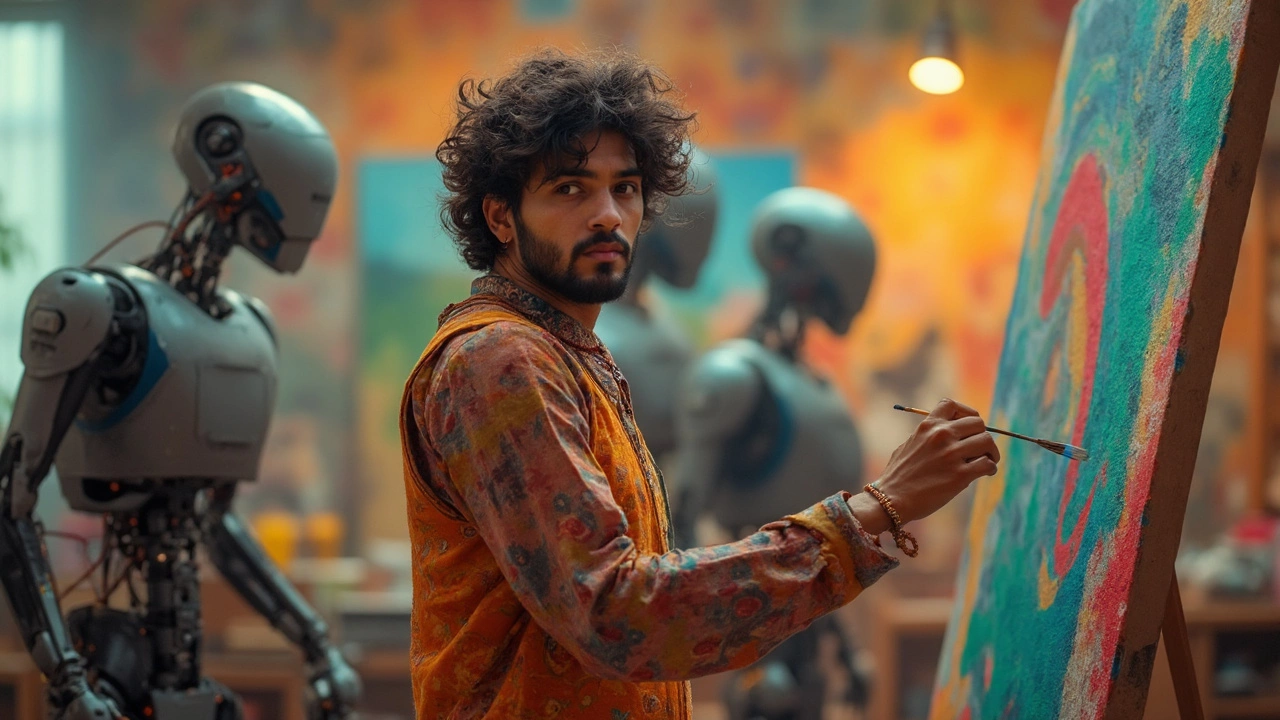AI-Proof Jobs: What AI Can't Replace (Yet)
 Jun, 9 2025
Jun, 9 2025
Every time a new AI tool goes viral, someone asks: “So, are all of us getting replaced next year?” Look, I get it. Watching AI pump out essays or code in a few seconds can be mind-blowing, but there are some jobs that don’t budge, no matter how smart these bots get.
Some work needs a real person—think of teachers calming down a tough classroom, a nurse gently explaining scary test results to a family, or a plumber figuring out a weird leak in your wall. Even the fanciest AI can’t handle messy realities or human mess-ups. These jobs call for intuition, emotional smarts, and hands-on skills that can’t be turned into ones and zeros.
Worrying about robots is natural—especially when you have kids, like my daughter Isha, who’s already dreaming up wild career choices. But the trick for all of us is figuring out where humans still shine. It's not just about being smart—it's about being real, being present, and knowing how to connect. Don’t focus on out-teching the bots; focus on what only people can do.
- Why AI Hits a Wall with Some Jobs
- The Power of Human Touch and Judgment
- Creative Roles: Where Imagination Wins
- Skilled Trades: Built on Experience, Not Code
- How to Stay Ahead of the AI Game
Why AI Hits a Wall with Some Jobs
AI is clever, but it still chokes on stuff that humans do without thinking. One huge issue? Context. AI relies on data. Give it a curveball—like sarcasm in a text, a subtle shift in mood, or a task that needs physical touch—and it just falls flat. Take hospitals, for example. AI can scan X-rays, but can it calm a scared kid or break tough news with real empathy? Not even close.
Here’s where the big roadblocks for AI come in:
- Human skills: Jobs like therapy, teaching, or nursing need a combination of emotional smarts, on-the-spot judgment, and reading social cues.
- Messy, unpredictable work: Think electricians who deal with wiring that’s not up to code or social workers managing chaotic family situations. AI struggles when every case is different.
- Dexterity: You wouldn’t trust a robot to do your kid’s haircut, right? Manual skills that involve a sense of touch or precision remain out of reach for most AI bots.
Here’s a quick look at what AI can and can’t do (as of 2025):
| Task Type | How AI Performs |
|---|---|
| Repetitive data entry | Excellent - fast and accurate |
| Emotional support (therapy, teaching) | Poor - lacks empathy and adaptation |
| Assembly line manufacturing | Good (with supervision) |
| Creative writing or art | Mixed – decent drafts, weak on originality |
| Physical dexterity (haircutting, plumbing) | Poor – struggles with unique, tactile tasks |
The bottom line? AI shines at clear, repetitive stuff, and anything that can be broken into simple rules. But once you add messy people, complex feelings, or hands-on work, humans still have the edge. If a job leans on a real person’s touch, judgment, or creativity, AI is nowhere near replacing it.
The Power of Human Touch and Judgment
Here’s where robots hit a wall: they don’t get what it’s like to be human. AI might recognize faces or sort emails, but it struggles when things get complicated, messy, or emotional. Picture sitting across from a counselor after you’ve had a rough day, or having a doctor deliver good—or bad—news face to face. Machines just can’t comfort or reassure people the way real humans do.
Let’s be blunt—jobs that rely on trust, empathy, and reading the room aren’t going away. Nurses calm patients in pain, social workers handle sensitive family issues, and therapists help people work through trauma. Even the best AI can fake texts, but can’t build real connection. It’s not just about saying the right thing—it’s about knowing when words matter and when a quiet nod is enough.
There’s real data backing this. A 2024 Pew Research Center study showed that 88% of Americans prefer talking to a real person, not a chatbot, for healthcare or emotional support. People want to be heard and understood, especially when stakes are high.
| Situation | % Preferring Human |
|---|---|
| Healthcare advice | 88% |
| Legal help | 82% |
| Mental health support | 91% |
| Family counseling | 90% |
Plus, humans can spot things that don’t fit a script. Ever had a gut feeling something’s off with your kid, even if all the "facts" look normal? That’s judgment. AI-proof jobs need this sixth sense. Teachers adjust their lesson plans on the fly when students seem lost. Customer service reps go off-script to solve real-life problems, not just read from a manual. Experienced managers can tell when a team is stressed, just by reading the room, not a spreadsheet.
Here’s the takeaway: if a job leans heavily on real emotions, nuanced communication, or snap decisions with no clear right answer, it’s not going anywhere soon. These are the jobs where people’s stories, personalities, and instincts matter most. Robots will always feel a step behind in these moments.

Creative Roles: Where Imagination Wins
Even the most advanced AI stumbles when it has to break the mold and think outside the box. Creative jobs like writers, designers, musicians, filmmakers, and advertising pros aren’t just ticking boxes or repeating old ideas—they’re inventing new things that people have never seen before. That’s a weak spot for AI. It can remix and mash up stuff it’s seen, but it can’t truly create something original without a nudge from a human brain.
“AI is good at pattern recognition, but it’s bad at things that require taste, intuition, and the ability to spot what no one else has noticed yet.” — Kevin Kelly, founding executive editor of Wired magazine
Best-selling authors like Margaret Atwood have said they’d never trust an algorithm to write a novel that really grabs you. It’s not just about stringing words together—it’s about knowing what actually hits home with real people. The same thing goes for comedians, artists, and game designers. A 2024 survey by Adobe showed that 82% of creative professionals felt their jobs would change with AI, but only 12% thought AI could fully do their work for them.
- Creating a movie script that stirs emotions? Still a human thing.
- Designing a brand identity that actually stands out? People-powered.
- Coming up with lyrics for a song that gives you goosebumps? AI just can’t.
Here’s some quick data on jobs that need real creativity:
| Job | AI Replaceable? | Why Not? |
|---|---|---|
| Novelist | No | Needs emotional connection, unique voice |
| Musician | No | Original composition, cultural instinct |
| Graphic Designer | Partly | AI tools help, but humans guide ideas |
| Stand-Up Comedian | No | Tone, timing, crowd reading |
If you like to dream, doodle, or tell stories, you’re on safer ground. The key? Use AI as a tool, not a boss. If you’re building a career in a creative field, focus on learning your craft deeply and developing your own taste. That’s what will set you apart while everyone else is asking ChatGPT for ideas.
Those who can combine tech with a strong imagination will ride higher in the AI-proof jobs future.
Skilled Trades: Built on Experience, Not Code
So here’s the straight truth: when it comes to fixing things up or building stuff with your hands, AI is still clueless. Sure, robots can help on factory lines or do simple tasks, but ask them to fix a leaky pipe in a 30-year-old apartment or wire up a funky old fuse box—you’ll just get error messages. That’s because skilled trade workers—like electricians, plumbers, carpenters, and mechanics—handle problems that don’t follow a script. Every job is a little different, which is why real experience still wins.
One study from the McKinsey Global Institute found that only about 20% of activities in skilled trades can be automated. The rest of the work needs critical thinking, hands-on know-how, and creative problem-solving on the spot. No AI can crawl under your sink, diagnose a unique problem, and chat with you about whether you want the cheap fix or the long-term solution.
"Machines are amazing at repetition, but skilled trades rely on adapting to unexpected situations. That’s human territory." — The Center for Workforce Success
People in these jobs also need to pay attention to safety rules, handle strange surprises, and work with heavy tools in awkward spaces. It’s not just about following instructions—it’s about reading a whole situation and reacting fast. Here’s a breakdown showing which skilled work is safe from being fully replaced by AI:
| Trade | Part AI Can Do | Part Only Humans Do |
|---|---|---|
| Plumber | Detect leaks with sensors | Diagnose pipe layout, cut and fit pipes, talk with homeowners |
| Electrician | Analyze basic wiring maps | Work in tight spaces, handle live wires, fix code violations |
| Mechanic | Run car diagnostics | Troubleshoot odd noises, hands-on repairs, explain issues to customers |
| Carpenter | Operate big cutting machines | Customize fitting in old houses, fine hand work, work with clients |
AI-proof jobs aren't going away anytime soon for a simple reason: these trades need a sharp mind, quick decisions, and a steady pair of hands. The best tradespeople keep learning. My tip? For anyone thinking about jumping into the trades, build your skills, build your network, and keep up with what’s new in your field. Tech tools can help, but they’re not your replacement—they’re just another tool in the belt.

How to Stay Ahead of the AI Game
If you want to protect your job from AI, it pays to keep learning. New tech won’t wait around. About 44% of work hours could be automated with existing tech, according to a 2024 McKinsey report. But jobs that mix human touch, problem-solving, and creativity are much safer.
Here’s what actually keeps you in business while automation climbs:
- AI-proof jobs build on skills that robots can't truly copy: empathy, critical thinking, strategic planning, and creativity. For example, teaching, therapy, and trades like plumbing and electrical work rely heavily on human interactions and context.
- Stay up-to-date: Make it a habit to learn new tools or skills every year. Even a short online course on teamwork, emotional intelligence, or basic coding can help you keep pace.
- Double down on what AI gets wrong. Machines fumble with nuanced conversations, ethics, and anything hands-on where every situation is a little bit different.
- Networking is key: Strong connections can open new roles or lead you into fields where tech still struggles. Real-world relationships make a difference.
- Take on more complex tasks in your current job. Bosses notice when you handle the problems nobody else wants to tackle.
Check out this quick table for ideas on where to upskill and where humans still win:
| Human Skill | AI Strength | Why It Matters |
|---|---|---|
| Empathy | Data analysis | People depend on trust and emotional connection |
| Hands-on work | Repetitive tasks | Physical jobs need real-time fixes and judgment |
| Creative thinking | Pattern recognition | Original ideas and complex stories stay human |
| Strategic planning | Automation at scale | Long-term decisions mix logic and intuition |
Bottom line? Focus on what makes you human and stay flexible. That’s your best bet for a future where AI is the tool—and not the competition.